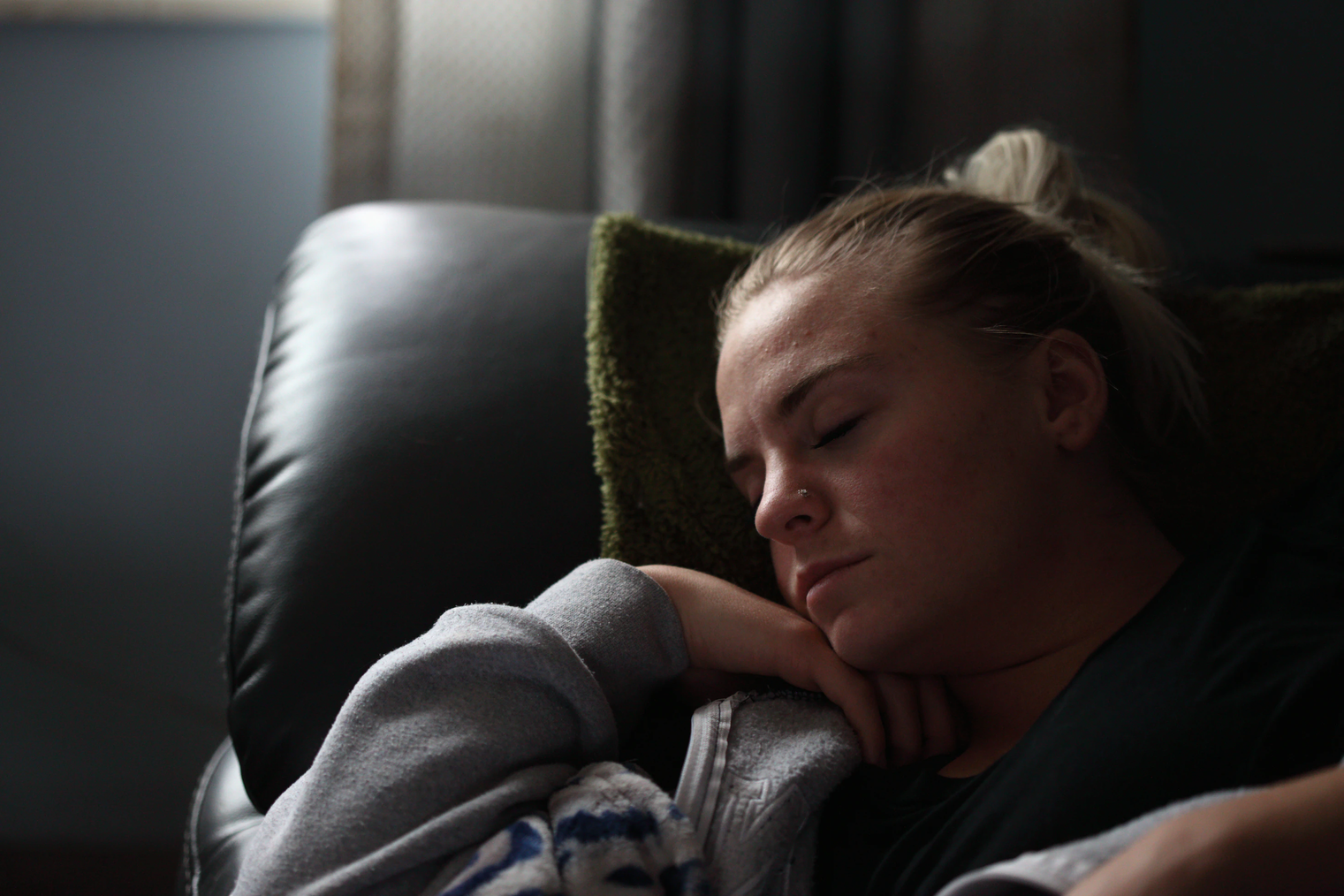Back pain can be a relentless companion, affecting your life in various ways. One of its significant impacts is on your sleep. Sleep is essential for the body's recovery and overall well-being, but back pain can make it challenging to find a comfortable sleeping position.
However, it's not a lost cause, as discovering the right sleeping position can significantly alleviate your discomfort and lead to better sleep quality.
Back pain often necessitates a personalized approach to sleeping positions. While one position may work well for one individual, it might not be suitable for another. In this article, we'll provide an in-depth exploration of five of the best sleeping positions for lower back pain.
Types of Lower Back Pain
Lower back pain can manifest in two primary forms: acute and chronic. Understanding the distinction between these two types is essential for effectively managing your condition.
-
Acute Back Pain: Acute back pain is typically characterized by its sudden onset and short-term duration. It often stems from a specific injury or strain, and while it can be intensely painful, it usually resolves within a few days to a few weeks with proper treatment and self-care. Acute back pain can significantly impact your daily life and, notably, your sleep quality.
-
Chronic Back Pain: Chronic back pain, on the other hand, is persistent and lasts for three months or more. It may result from an underlying medical condition, such as arthritis or a herniated disc. Chronic back pain can be debilitating and significantly disrupt your daily life and sleep patterns.
The repercussions of lower back pain extend far beyond physical discomfort. Back pain, whether acute or chronic, can have a profound impact on your daily life and, more specifically, your sleep.
The pain and discomfort may make it difficult to find a comfortable sleeping position, leading to frequent awakenings during the night. Lack of quality sleep, in turn, can exacerbate your pain and impact your ability to perform daily tasks with focus and energy.
Chronic back pain, in particular, can lead to a reduced quality of life and mental health issues, as the constant pain wears on your emotional well-being. Understanding the interplay between back pain and sleep is crucial for effectively addressing your condition and improving your overall well-being.

How Are Sleep and Lower Back Pain Related?
Back pain and sleep problems often go hand in hand, creating a challenging cycle that affects both your physical and mental well-being.
The pain and discomfort caused by lower back issues can make it difficult to find a comfortable sleeping position, leading to sleep disruptions and frequent awakenings during the night. This interrupted sleep pattern can leave you feeling fatigued and less able to cope with the pain the following day.
Sleep problems related to back pain can include difficulty falling asleep, staying asleep, or achieving restful and restorative sleep. The lack of quality sleep can lead to a reduced quality of life, impacting your ability to perform daily tasks with focus and energy.
It can also contribute to emotional distress, leading to irritability, anxiety, and depression.
The relationship between sleep and lower back pain is a two-way street. Not only can back pain disrupt your sleep, but sleep problems can also worsen your perception of pain.
Sleep is a crucial time for the body's recovery and healing, and when sleep is disrupted or inadequate, your body's ability to manage pain is compromised.
Sleep deprivation can increase pain sensitivity and lower your pain threshold, making your back pain feel more intense. The body's inflammatory response may also be heightened when sleep is lacking, further exacerbating pain and discomfort.
This bidirectional relationship underscores the importance of addressing both sleep problems and back pain together to achieve meaningful relief and improve your overall well-being.
How Do Sleeping Positions Affect Lower Back Pain?
Achieving proper spinal alignment during sleep is crucial for individuals experiencing lower back pain. The alignment of your spine plays a significant role in reducing pressure on the lower back and promoting a comfortable and restorative night's sleep.
The choice of a suitable sleeping position can contribute to maintaining this alignment, ultimately alleviating discomfort and reducing the risk of exacerbating existing back pain.
Finding the best sleeping position for lower back pain can be a transformative step in managing your discomfort and improving sleep quality. Below, we'll explore five of the most effective sleeping positions for individuals dealing with lower back pain:
-
Side Sleeping in a Fetal Position: This position involves curling your body into a fetal pose, with your knees drawn up towards your chest. This posture can help maintain the natural curve of your spine and relieve pressure on your lower back.
-
Back Sleeping in a Reclined Position: Back sleeping with your upper body slightly elevated can promote proper spinal alignment and reduce strain on the lower back. Placing a pillow under your knees can provide additional support.
-
Side Sleeping with Knee Support: Side sleeping with a pillow placed between your knees can prevent your legs from pulling your spine out of alignment. This position can ease the pressure on the lower back and hips.
-
Stomach Sleeping with Pillow Support: While stomach sleeping is generally not recommended for back pain, some individuals find relief by placing a pillow under their pelvis or lower abdomen to minimize arching of the lower back.
-
Flat Back Sleeping with Knee Support: Sleeping on your back with a small pillow or cushion under your knees can promote a neutral spinal position. This can relieve pressure on the lower back and enhance your sleep comfort.
Understanding the mechanics and benefits of these sleeping positions is essential for making an informed choice that suits your specific needs and provides relief from lower back pain. The right sleeping position can significantly alleviate discomfort and contribute to a more restful night's sleep.

Can Your Mattress Cause Lower Back Pain?
The mattress you sleep on plays a pivotal role in supporting your body during sleep, including the alignment of your spine and the relief of lower back pain. An unsuitable mattress can exert pressure on certain areas of the body, leading to discomfort and disrupted sleep.
Understanding how your mattress impacts your sleep quality and back pain is essential for achieving better rest.
Choosing the Right Mattress Firmness
Selecting the right mattress firmness is a crucial decision, especially if you suffer from lower back pain. The level of firmness you choose should align with your specific needs and sleeping preferences.
A mattress that is too soft may not provide adequate support, causing the spine to sink and creating strain on the lower back. On the other hand, an overly firm mattress may not contour to your body's natural curves, resulting in discomfort.
By selecting the appropriate firmness level, you can ensure your mattress actively contributes to relieving lower back pain.
The condition of your mattress can have a direct impact on your lower back pain and overall sleep quality. Over time, mattresses can wear out, leading to sagging and uneven surfaces.
This degradation can disrupt spinal alignment and contribute to discomfort. It's essential to regularly assess the condition of your mattress and replace it if necessary to maintain the support it provides.
By choosing the right firmness and ensuring your mattress is in optimal condition, you can create an environment that enhances your sleep quality and promotes spinal health.

How to Sleep Better With Lower Back Pain
Coping with lower back pain and improving sleep quality can be a challenging but achievable goal with the right strategies. Here are some tips for getting better sleep with back pain:
-
Finding a Supportive Sleeping Position: As discussed earlier, choosing a supportive sleeping position that aligns your spine can significantly reduce discomfort. Experiment with various positions and pillows until you find the one that works best for you.
-
Avoiding Alcohol and Caffeine: Alcohol and caffeine can disrupt your sleep patterns and make it more challenging to achieve restful sleep. Avoiding these substances, especially in the hours leading up to bedtime, can promote better sleep quality.
-
Practicing Relaxation Techniques: Relaxation techniques such as deep breathing exercises, meditation, and progressive muscle relaxation can help reduce tension and promote a state of relaxation conducive to sleep.
-
Reducing Sleep Disruptions: Identify and address factors that disrupt your sleep, such as noise, light, or temperature. Creating a comfortable and soothing sleep environment can contribute to better rest.
-
Finding Sleep Supplements: Sleeping supplements, such as melatonin gummies, can help you fall asleep more easily even with disruptive back pain. Keep in mind, however, that melatonin can interact with medications, so it’s best to consult a healthcare professional when taking pain medication.
Sleep hygiene encompasses a set of practices and habits that foster good sleep quality. Maintaining proper sleep hygiene is crucial for everyone, but it becomes even more critical when dealing with lower back pain.
A healthy sleep routine can include factors like consistent bedtime and wake times, creating a relaxing pre-sleep routine, and ensuring your sleep environment is conducive to rest. By prioritizing sleep hygiene, you can enhance your sleep quality and, in turn, manage your lower back pain more effectively.
When Should You See a Doctor About Lower Back Pain
While many cases of lower back pain can be managed with self-care and lifestyle adjustments, there are instances where seeking medical attention is essential. Identifying red flags that indicate the need for prompt medical evaluation is crucial. Some of these red flags include:
-
Persistent and Severe Pain: If your lower back pain is severe and does not improve with rest or over-the-counter pain medications, it's a sign that you should seek medical advice.
-
Pain Radiating Down the Leg: Pain that radiates down your leg, often accompanied by numbness or weakness, could be a sign of nerve compression or other serious issues that require medical attention.
-
Bladder or Bowel Dysfunction: Any changes in bladder or bowel function, such as difficulty in urinating or controlling your bowels, should be addressed promptly.
-
Trauma or Injury: If your lower back pain is the result of a recent injury or trauma, it's important to consult a healthcare professional to rule out fractures or other significant damage.
-
Fever Alongside Pain: The presence of fever in conjunction with lower back pain may indicate an underlying infection or inflammation requiring medical assessment.
When you experience persistent or severe lower back pain, consulting a healthcare provider is the best course of action.
A doctor can conduct a thorough evaluation, which may involve physical exams, imaging tests, and medical history assessments to determine the underlying cause of your pain. Once a diagnosis is made, the doctor can recommend an appropriate treatment plan tailored to your specific condition.
Treatment options can range from physical therapy and pain management to surgical interventions, depending on the severity and nature of the issue.
In many cases, early intervention by a healthcare provider can prevent the condition from worsening and improve your chances of finding effective relief from lower back pain.

Embracing Quality Sleep for Lower Back Pain Relief
Quality sleep plays a pivotal role in managing and alleviating lower back pain. The restorative and healing processes that occur during sleep can aid in reducing pain sensitivity and promoting overall well-being.
Recognizing the value of quality sleep is essential for individuals dealing with back pain, as it can lead to improved pain management and enhanced daily functioning.
Finding the right sleeping position for managing lower back pain is a highly personalized journey. What works for one person may not be suitable for another.
The key is to explore different positions and strategies to determine what best supports your specific condition and comfort. By taking a personalized approach to your sleeping position, you can enhance your sleep quality and reduce discomfort.
While self-care and lifestyle adjustments can be effective for managing some instances of lower back pain, persistent or severe pain should not be ignored. Seeking medical advice and assessment is vital in such cases.
Healthcare providers can diagnose the underlying causes of your pain and offer tailored treatment options to alleviate your discomfort. Don't hesitate to consult a medical professional if you're experiencing ongoing back pain that hinders your daily life and sleep. Your well-being is worth the attention and care of a healthcare expert.









